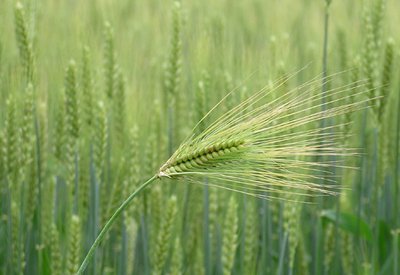Veronica I Polniak, Jaron Lewton, Medhat A Michael, Kyan M Thelen, Adam J Moeser, Dale W Rozeboom
 Two experiments were
conducted to understand the growth and health benefits of including treated
wheat straw in weanling pig diets. The first experiment evaluated feeding
treated versus untreated wheat straw on young pig growth performance and
localized immunological markers. One hundred and ninety-two (PIC 359 x
Yorkshire) pigs were weaned at 26.8 ± 1.1 d old (8.3 ± 1.1 kg) and randomly
allotted to 24 pens with 8 pigs per pen. Three dietary treatments were fed over
a 28-d period, control (CON), control plus 5% untreated wheat straw (UWS), and
control plus 5% treated wheat straw (TWS). Diets were formulated to meet or
exceed all nutrient requirements of NRC, 2012. Growth performance data was
recorded on a weekly basis. One pig per pen (equal number of males and females)
was randomly selected for sacrifice and sample collection on d 28. The second
experiment evaluated the impact of 5% dietary TWS on the local and systemic
health of nursery pigs experiencing a vaccination-induced immune challenge. Twenty
barrows (PIC 800 x Yorkshire) were weaned at 27.7 ± 0.75 d (8.6 ± 1.2 kg) and
assigned to four pens, with 5 pigs per pen. A heavy and light-weight pen for
each treatment (CON and TWS) resulted. All pigs were sacrificed for sample
collection on d 42. In both experiments, before euthanasia, blood was collected
to assess plasma immunoglobulin A (IgA) and intestinal fatty acid binding
protein (iFABP) concentration. Upon sacrifice, segments of the distal ileum and
ascending colon were removed to collect mucosal scrapings for the analysis of
localized immunological markers interleukin (IL) 6, IL-10, IL-12, and tumor
necrosis factor-alpha (TNF-α). In experiment one,
overall ADG and ADFI were similar among treatments. Gain-to-feed
ratio of TWS pigs was greater (P < 0.05) than that of UWS pigs and tended to
be greater (P = 0.07) than that of CON pigs (0.70, 0.67, and 0.68, respectively;
SEM = 0.01). Both straw treatments decreased the expression of ileal and
colonic mucosa IL-6, in addition with less expression of ileal IL-12. Plasma
IgA concentrations in UWS pigs were greater than those in CON and TWS pigs (P
< 0.05). In experiment two, TWS pigs had greater
gene expression of colonic TNF-α and IL-6 (P < 0.05). Ileal gene or
protein expression of markers did not differ, nor did amounts of plasma IgA or
iFABP. Overall, feeding 5% treated wheat straw in the nursery pig diet does not
negatively impact growth and results in increased feed efficiency. Nursery diets with 5% treated wheat straw can impact the
expression of immune markers in the gut, but the question of how this is
related to performance and overall health needs
further elucidation.
Two experiments were
conducted to understand the growth and health benefits of including treated
wheat straw in weanling pig diets. The first experiment evaluated feeding
treated versus untreated wheat straw on young pig growth performance and
localized immunological markers. One hundred and ninety-two (PIC 359 x
Yorkshire) pigs were weaned at 26.8 ± 1.1 d old (8.3 ± 1.1 kg) and randomly
allotted to 24 pens with 8 pigs per pen. Three dietary treatments were fed over
a 28-d period, control (CON), control plus 5% untreated wheat straw (UWS), and
control plus 5% treated wheat straw (TWS). Diets were formulated to meet or
exceed all nutrient requirements of NRC, 2012. Growth performance data was
recorded on a weekly basis. One pig per pen (equal number of males and females)
was randomly selected for sacrifice and sample collection on d 28. The second
experiment evaluated the impact of 5% dietary TWS on the local and systemic
health of nursery pigs experiencing a vaccination-induced immune challenge. Twenty
barrows (PIC 800 x Yorkshire) were weaned at 27.7 ± 0.75 d (8.6 ± 1.2 kg) and
assigned to four pens, with 5 pigs per pen. A heavy and light-weight pen for
each treatment (CON and TWS) resulted. All pigs were sacrificed for sample
collection on d 42. In both experiments, before euthanasia, blood was collected
to assess plasma immunoglobulin A (IgA) and intestinal fatty acid binding
protein (iFABP) concentration. Upon sacrifice, segments of the distal ileum and
ascending colon were removed to collect mucosal scrapings for the analysis of
localized immunological markers interleukin (IL) 6, IL-10, IL-12, and tumor
necrosis factor-alpha (TNF-α). In experiment one,
overall ADG and ADFI were similar among treatments. Gain-to-feed
ratio of TWS pigs was greater (P < 0.05) than that of UWS pigs and tended to
be greater (P = 0.07) than that of CON pigs (0.70, 0.67, and 0.68, respectively;
SEM = 0.01). Both straw treatments decreased the expression of ileal and
colonic mucosa IL-6, in addition with less expression of ileal IL-12. Plasma
IgA concentrations in UWS pigs were greater than those in CON and TWS pigs (P
< 0.05). In experiment two, TWS pigs had greater
gene expression of colonic TNF-α and IL-6 (P < 0.05). Ileal gene or
protein expression of markers did not differ, nor did amounts of plasma IgA or
iFABP. Overall, feeding 5% treated wheat straw in the nursery pig diet does not
negatively impact growth and results in increased feed efficiency. Nursery diets with 5% treated wheat straw can impact the
expression of immune markers in the gut, but the question of how this is
related to performance and overall health needs
further elucidation.
Journal of Animal Science, Volume 101, Issue Supplement_3, November 2023, Pages 184–185, https://doi.org/10.1093/jas/skad281.224
Registration hotline: 021-57634675
fax: 021-57632800
Copy right : 上海亘泰实业集团
Collaboration & Sponsorship: 021-57634938 57631012
ASASHotline:021-67868428
Site Map | CNZZStatistics
address:Shanghai songjiang jiuting town nine new highway 90 lane 3 nine new commercial building 15 floor

WeChat ID:asaschina
The pig nutrition international BBS CSIS